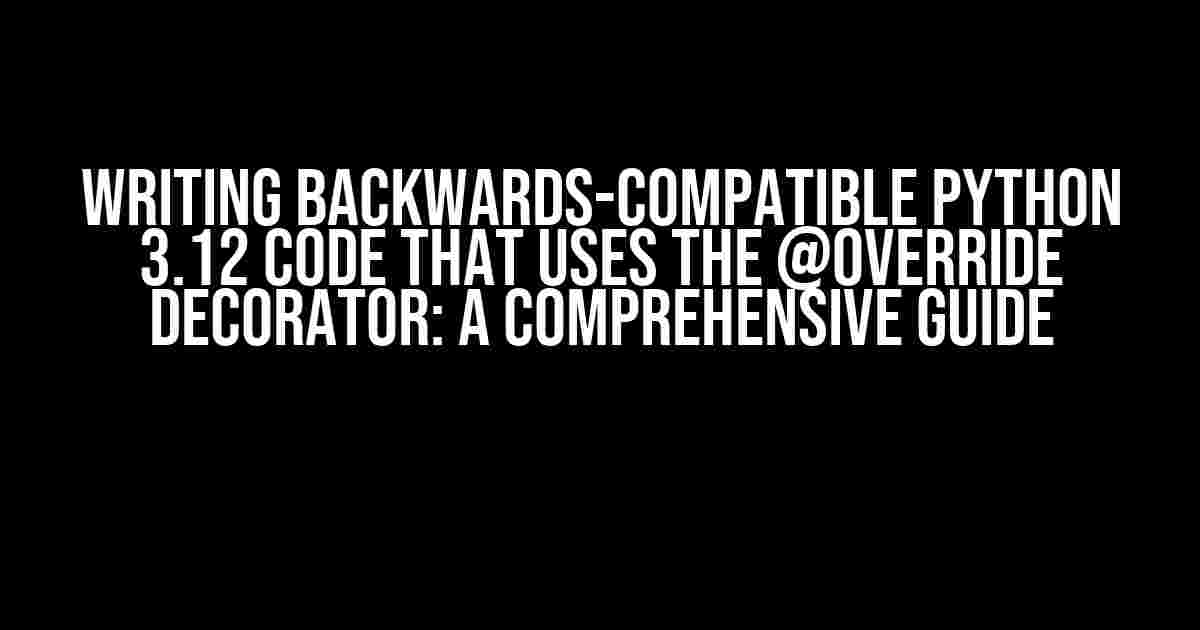Introduction
As Python developers, we strive to write code that is not only efficient and effective but also future-proof. With the release of Python 3.12, we have access to exciting new features and improvements. One of these features is the @override decorator, which allows us to explicitly indicate when a subclass intends to override a method from its parent class. However, as we adopt this new syntax, we must also ensure that our code remains backwards-compatible with earlier versions of Python. In this article, we’ll delve into the world of writing backwards-compatible Python 3.12 code that leverages the power of the @override decorator.
Understanding the @override Decorator
Before we dive into writing backwards-compatible code, let’s take a closer look at the @override decorator itself. Introduced in Python 3.12, this decorator is used to inform the Python interpreter that a subclass intends to override a method from its parent class. This explicit indication helps catch potential errors and improves code readability.
from abc import ABC, abstractmethod
class Animal(ABC):
@abstractmethod
def sound(self):
pass
class Dog(Animal):
@override
def sound(self):
print("Woof!")
In the above example, the `@override` decorator is used to indicate that the `sound` method in the `Dog` class overrides the abstract method from the `Animal` class.
Challenges of Writing Backwards-Compatible Code
When writing code that targets Python 3.12, we must consider the fact that earlier versions of Python do not support the @override decorator. This means that our code must be compatible with Python 3.6, 3.7, 3.8, 3.9, and 3.10, which do not have this feature. To overcome this challenge, we’ll use a combination of techniques to ensure our code works seamlessly across different Python versions.
Technique 1: Check for Python Version
One approach is to check the Python version at runtime and use the @override decorator only when running on Python 3.12 or later. We can achieve this using the `sys` module and a simple conditional statement.
import sys
def override_decorator(func):
if sys.version_info.major == 3 and sys.version_info.minor >= 12:
return override(func)
return func
class Animal(ABC):
@abstractmethod
def sound(self):
pass
class Dog(Animal):
@override_decorator
def sound(self):
print("Woof!")
In this example, we define a custom decorator `override_decorator` that checks the Python version. If we’re running on Python 3.12 or later, it applies the @override decorator to the function. Otherwise, it returns the original function unchanged.
Technique 2: Use a Compatibility Layer
Another approach is to create a compatibility layer that provides the @override decorator functionality for earlier Python versions. We can achieve this by defining a custom decorator that mimics the behavior of the @override decorator.
class override_compat:
def __init__(self, func):
self.func = func
def __call__(self, *args, **kwargs):
return self.func(*args, **kwargs)
class Animal(ABC):
@abstractmethod
def sound(self):
pass
class Dog(Animal):
@override_compat
def sound(self):
print("Woof!")
In this example, we define a custom decorator `override_compat` that simply returns the original function. This decorator can be used as a drop-in replacement for the @override decorator, ensuring compatibility with earlier Python versions.
Technique 3: Use a Third-Party Library
A third approach is to rely on a third-party library that provides backwards-compatibility for the @override decorator. One such library is `backports.override`, which can be installed using pip:
pip install backports.override
Once installed, we can use the `@override` decorator from the `backports.override` library, which provides compatibility with earlier Python versions.
from backports.override import override
class Animal(ABC):
@abstractmethod
def sound(self):
pass
class Dog(Animal):
@override
def sound(self):
print("Woof!")
Best Practices for Writing Backwards-Compatible Code
When writing code that targets multiple Python versions, it’s essential to follow best practices to ensure compatibility and maintainability. Here are some guidelines to keep in mind:
- Use compatible syntax: Avoid using syntax that is specific to Python 3.12 or later, such as the @override decorator, unless you have a compatibility layer in place.
- Check for Python version: Use the `sys` module to check the Python version at runtime and adapt your code accordingly.
- Use third-party libraries: Leverage third-party libraries that provide backwards-compatibility for new features, such as the `backports.override` library.
- Test thoroughly: Test your code on multiple Python versions to ensure compatibility and catch potential errors.
- Document your code: Clearly document your code, including any compatibility layers or workarounds, to make it easier for other developers to understand and maintain.
Conclusion
Writing backwards-compatible Python 3.12 code that uses the @override decorator requires careful consideration and planning. By using techniques such as checking for Python version, creating a compatibility layer, or relying on third-party libraries, we can ensure that our code works seamlessly across different Python versions. Remember to follow best practices, test thoroughly, and document your code to make it maintainable and easy to understand. With these strategies in place, you’ll be well on your way to writing robust, future-proof code that takes advantage of the latest Python features.
| Technique | Description |
|---|---|
| Check for Python Version | Use the `sys` module to check the Python version at runtime and adapt your code accordingly. |
| Use a Compatibility Layer | Create a custom decorator that mimics the behavior of the @override decorator for earlier Python versions. |
| Use a Third-Party Library | Rely on a third-party library, such as `backports.override`, to provide backwards-compatibility for the @override decorator. |
By following these techniques and best practices, you’ll be able to write Python 3.12 code that uses the @override decorator and remains compatible with earlier Python versions. Happy coding!
- Python 3.x documentation: abc – Abstract Base Classes
- backports.override – A backport of the override decorator from Python 3.12
- PEP 615 – Decorator for explicit override indication
Frequently Asked Question
Writing backwards-compatible Python 3.12 code that uses the @override decorator can be a bit tricky, but don’t worry, we’ve got you covered! Here are some frequently asked questions to help you navigate this complex topic.
What is the @override decorator, and why do I need it in Python 3.12?
The @override decorator is a special marker in Python 3.12 that indicates a method is intended to override a method from its parent class. You need it to ensure that your code is backwards-compatible with older Python versions and to avoid any unexpected behavior.
How do I use the @override decorator correctly in Python 3.12?
To use the @override decorator correctly, you need to place it immediately before the method definition that you want to override. For example, `class MyClass(BaseClass): @override def my_method(self): …`. This ensures that the method is properly registered as an override.
What happens if I forget to use the @override decorator in Python 3.12?
If you forget to use the @override decorator, Python 3.12 will not raise an error, but your code may not behave as expected. The method will not be registered as an override, and you may encounter unexpected behavior or errors at runtime.
Is the @override decorator required in all Python versions, or just Python 3.12?
The @override decorator is specific to Python 3.12 and later versions. In earlier Python versions, you don’t need to use this decorator, but it’s still a good practice to use it for clarity and backwards-compatibility.
Can I use the @override decorator with other decorators, like @property or @classmethod?
Yes, you can use the @override decorator with other decorators, but make sure to place the @override decorator immediately before the method definition. The order of decorators can affect the behavior of your code, so be careful when combining multiple decorators.




